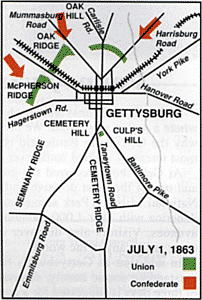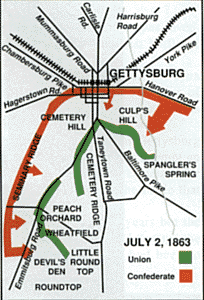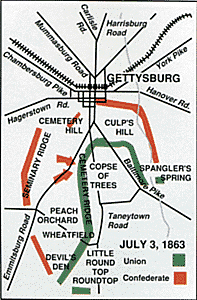GETTYSBURG CAMPAIGN
June 3-30, July 1-3, 1863
The Battle of Gettysburg, one of the most important battles of the U.S. Civil War, was fought at Gettysburg, Pa., on July 1-3, 1863. Gen. Robert E. Lee invaded Pennsylvania for strategical and logistical reasons. His army of about 75,000 encountered the Union Army of the Potomac, about 90,000 strong, under Gen. George G. Meade on the outskirts of Gettysburg on July 1. In a battle of considerable movement, Lee tested first the Union right (July 1) and then, in an assault led by Gen. James Longstreet, the left (July 2). On July 3, Gen. George Pickett led perhaps the most famous charge in American military history against the Union center. Only 5,000 of his original force of 15,000 survived the repulse.
Lee watched the survivors return and confessed, "It is all my fault." Gettysburg, a military and logistical disaster for the South, cost Lee 20,000 men (killed and wounded) and 30,000 arms. Meade lost almost as many men. The battle had considerable psychological effect on both North and South, calling forth President Lincoln's Gettysburg Address. Occurring in the same week that Vicksburg fell to Gen. Ulysses S. Grant, Gettysburg put the Confederates on the defensive in the east.
========================
June 3-30, 1863
========================
Following his victory at Chancellorsville in May, 1863, General Lee received approval from his government to invade the north. Lee hoped an invasion would fuel the northern peace movement and, at least, disrupt the Union war effort. After the death of Stonewall Jackson, Lee's Army of Northern Virginia, 75,000-strong, had been reorganized into three army corps under Longstreet, Ewell, and A.P. Hill, with a cavalry division under J.E.B. Stuart. On June 3, advance troops of the Confederate army left their camps near Fredericksburg and marched west toward the Shenandoah Valley.
The 95,000-strong Federal Army of the Potomac, under General Hooker, was initially uncertain of Lee's intentions. On June 9, Hooker ordered cavalry general Alfred Pleasonton to conduct a reconnaissance with 11,000 men across the Rappahannock River toward Brandy Station. Pleasonton ran into Stuart's cavalry, and the largest cavalry battle of the war ensued. The result was a standoff, but the Federals were now alerted to the Confederate army's movements.
By June 13, elements of Ewell's corps appeared before Winchester. On the same day, Hooker with-drew the Army of the Potomac from the Rappahannock and ordered it north. On June 14-15, Ewell attacked the 9,000-strong Federal garrison at Winchester and defeated it, inflicting heavy losses and capturing much valuable war material.
After Winchester, Lee's army moved unchecked into the Cumberland Valley of Pennsylvania. On June 25, Lee agreed to Stuart's plan to take three brigades of cavalry across the Potomac cast of the Blue Ridge Mountains, and cut across the rear of the Federal army. Stuart's march encountered frequent delays and detours and an increasingly aggressive Federal cavalry, and was unable to rejoin Lee until July 2.
By June 28, Longstreet and Hill's corps were at Chambersburg. Divisions of Ewell's corps had crossed the mountains to York and Carlisle, and were preparing to move against Harrisburg. However, Lee learned on this day that the Federal army was at Frederick, and that Hooker had been replaced by General Meade. Lee decided to bring his entire army east of the mountains and offer battle. At the same time, Meade moved his army north. By June 30, both armies were converging upon Gettysburg and the battle, which would be the turning point of the war, was set to commence.
=====================
July 1 1863
=====================
 After the discovery on June 30 that Gettysburg was occupied by Brigadier General John Buford's division of Federal cavalry, the Confederates on July 1 sent the divisions of Major General Henry Heth and Major General William Pender of Hill's Corps, down the Chambersburg Road to drive Buford away and occupy Gettysburg.
After the discovery on June 30 that Gettysburg was occupied by Brigadier General John Buford's division of Federal cavalry, the Confederates on July 1 sent the divisions of Major General Henry Heth and Major General William Pender of Hill's Corps, down the Chambersburg Road to drive Buford away and occupy Gettysburg.
The battle began at 5.30 a.m., when shots were exchanged over Marsh Creek. In the face of Buford's resistance, Heth pushed on cautiously until he reached a point about two miles west of Gettysburg. Here he deployed two brigades in line, and pressed ahead; it was nearly 10 a.m. Federal General John F. Reynolds, commanding I Corps, arrived on the field at this point, and determined to engage Herb. He ordered I Corps and Major General Oliver 0. Howard's XI Corps to march to Gettysburg.
Soon after 10.30 a.m., I Corps arrived and engaged Heth along McPherson's Ridge. By 11.30 a.m., Heth had been defeated and forced to withdraw to Herr Ridge. Early in the action, Reynolds was killed, and field command devolved upon Howard. A lull now settled over the field as both sides brought up reinforcements. The Federal I Corps deployed to defend the western approaches to Gettysburg, while XI Corps formed up north of the town. Buford's cavalry covered the flanks. Howard left one division in reserve on Cemetery Hill. His strategy was simple: delay the Confederates long enough to enable the rest of the Federal army to concentrate.
Lee arrived on the field after noon. He had initially hoped to avoid a general engagement since the strength of the enemy was unknown, and the terrain in the Gettysburg area unfamiliar. But, soon after noon, Rodes's division of Ewell's Corps arrived on Oak Hill and attacked the right of I Corps. At 2 p.m. Heth's division joined the attack on I Corps. At 3 p.m., the battle spread north of the town when Jubal Early's division of Ewell's Corps attacked down the Harrisburg Road and crushed the flank of XI Corps. At about the same time, west of Gettysburg, Pender's division relieved Heth and assaulted I Corps' position along Seminary Ridge. By 4 p.m., both Federal corps were in retreat through Gettysburg to Cemetery Hill. Federal losses numbered slightly over 9,000, including some 3,000 captured, compared with Confederate losses of about 6,500.
The day's action had resulted in a Confederate victory, but Federal forces held onto the high ground south of Gettysburg, where their position was soon strengthened by reinforcements.
=====================
July 2 1863
=====================
 The success of his army in the fighting on July 1 encouraged Lee to renew the battle on July 2. An early morning reconnaissance of the Federal left revealed that their line did not extend as far south as Little Round Top. Lee directed Longstreet to take two divisions of I Corps and march south until they reached the flank of the Federal forces. They would attack from this point, supported by a division of A.P. Hill's corps - a total force of nearly 20,000 men. While Longstreet carried out the main offensive, Ewell was ordered to conduct a demonstration against the Federal right. However, he was given discretion to mount a full-scale attack should the opportunity present itself.
The success of his army in the fighting on July 1 encouraged Lee to renew the battle on July 2. An early morning reconnaissance of the Federal left revealed that their line did not extend as far south as Little Round Top. Lee directed Longstreet to take two divisions of I Corps and march south until they reached the flank of the Federal forces. They would attack from this point, supported by a division of A.P. Hill's corps - a total force of nearly 20,000 men. While Longstreet carried out the main offensive, Ewell was ordered to conduct a demonstration against the Federal right. However, he was given discretion to mount a full-scale attack should the opportunity present itself.
The Federal army was well prepared for Lee's offensive. Six of its seven corps had arrived on the battlefield, and VI Corps was making a thirty-six-mile forced march to reach it. Meade had deployed his army in a fish-hook-shaped formation, with the right on Culp's Hill and Cemetery Hill, the center along Cemetery Ridge, and the left on Little Round Top. The left of the Federal lin c was held by Major General Daniel Sickles's III Corps. Sickles was dissatisfied with his assigned position and in the early afternoon, without orders, he advanced his line nearly half a mile west in order to take advantage of the high open ground around a nearby peach orchard.
Soon after Sickles took up this new position, Longstreet attacked. Third Corps was hard pressed and Meade sent V Corps and part of 11 Corps to reinforce Sickles in the Peach Orchard. But, after furious fighting, Longstreet's forces broke through, causing Sickles's entire line to collapse. The Confederates pursued to the base of Little Round Top, but Federal reinforcements, including elements of VI Corps, checked their advance. Farther north, elements of a division of the Confederate III Corps advanced to the slopes of Cemetery Ridge before they too were forced to retire.
On the Federal right, Ewell did not attack until evening, after Longstreet's onslaught had subsided. The effort to storm Cemetery Hill was ultimately unsuccessful. Ewell's attacks were also repulsed at Culp's Hill, although a foothold was gained near the base of the hill.
The second day's fighting had cost each army some 9,000 casualties. Lee's forces had again gained ground, but had failed to dislodge the Federal army from its strong position.
=====================
July 3 1863
=====================
 Lee's confidence was unshaken by the events of July 2. That night, he ordered Longstreet, who had been reinforced by Major General George Pickett's division, to renew his assault on the Federal left. Simultaneously, Ewell, who had also been reinforced, was to storm Culp's Hill. Stuart's cavalry, which had rejoined the army late that day, was ordered to march well east of Gettysburg, and attempt to penetrate to the Federal rear where they might disrupt communications and distract Meade.
Lee's confidence was unshaken by the events of July 2. That night, he ordered Longstreet, who had been reinforced by Major General George Pickett's division, to renew his assault on the Federal left. Simultaneously, Ewell, who had also been reinforced, was to storm Culp's Hill. Stuart's cavalry, which had rejoined the army late that day, was ordered to march well east of Gettysburg, and attempt to penetrate to the Federal rear where they might disrupt communications and distract Meade.
Meanwhile, Meade had determined to hold his position and await Lee's attack. However, at Culp's Hill he authorized XII Corps to drive Ewell's forces out of the captured Federal trenches at daylight. The Federal effort opened with a concentrated artillery bombardment which precipitated a tremendous musketry battle.
With Ewell already engaged, Lee rode to Longstreet's headquarters to observe his preparations for the attack on the Federal left. Longstreet misunderstood his orders and was planning instead a movement to turn the Federal left. With the hope of a coordinated attack now lost, Lee was forced to modify his plans. He determined to shift his main attack to the Federal center on Cemetery Ridge. Longstreet was placed in command of the effort. The plan was first to subject the Federal position to bombardment by nearly 140 cannon, then to send Pickett, Pettigrew and half of Trimble's divisions (formerly Heth's and Pender's) - nearly 12,000 men - forward to smash the Federal center.
While Longstreet made his preparations during the morning, Ewell's forces were defeated in their counterattacks on Culp's Hill, and withdrew around 11:00 a.m.
At l:00 pm, Longstreet opened the great bombardment of the Federal line. The Federal army replied with approximately 80 cannon and a giant duel ensued which lasted for nearly two hours. After the bombardment subsided, the infantry went forward. This has subsequently been known throughout history as "Pickett's Charge."Federal artillery, followed by musketry, cut their formations to pieces and inflicted devastating losses. A small Confederate force effected one small penetration of the Federal line, but was overwhelmed. The attack ended in disaster, with nearly 5,600 Confederate casualties. Meanwhile, three miles east of Gettysburg, Stuart's cavalry was engaged by Federal cavalry under Brigadier General David Gregg. The cavalry clash was indecisive, but Stuart was neutralized and posed no threat to the Federal rear.
The battle was effectively over. Federal losses numbered approximately 23,000, while estimates of Confederate losses range between 20,000 and 28,000.
Source:
This description of the battle was taken for the most part from James M. McPherson's The Atlas of the Civil War.
Last Updated 15 April 2002

It was the best of times, it was the worst of times
Click on any [Item] below to go to that page
[Return to Glossary Page]
[Return to 43rd Pennsylvania Home Page]

© 1998-2004 Benjamin M. Givens, Jr.

 After the discovery on June 30 that Gettysburg was occupied by Brigadier General John Buford's division of Federal cavalry, the Confederates on July 1 sent the divisions of Major General Henry Heth and Major General William Pender of Hill's Corps, down the Chambersburg Road to drive Buford away and occupy Gettysburg.
After the discovery on June 30 that Gettysburg was occupied by Brigadier General John Buford's division of Federal cavalry, the Confederates on July 1 sent the divisions of Major General Henry Heth and Major General William Pender of Hill's Corps, down the Chambersburg Road to drive Buford away and occupy Gettysburg.
 The success of his army in the fighting on July 1 encouraged Lee to renew the battle on July 2. An early morning reconnaissance of the Federal left revealed that their line did not extend as far south as Little Round Top. Lee directed Longstreet to take two divisions of I Corps and march south until they reached the flank of the Federal forces. They would attack from this point, supported by a division of A.P. Hill's corps - a total force of nearly 20,000 men. While Longstreet carried out the main offensive, Ewell was ordered to conduct a demonstration against the Federal right. However, he was given discretion to mount a full-scale attack should the opportunity present itself.
The success of his army in the fighting on July 1 encouraged Lee to renew the battle on July 2. An early morning reconnaissance of the Federal left revealed that their line did not extend as far south as Little Round Top. Lee directed Longstreet to take two divisions of I Corps and march south until they reached the flank of the Federal forces. They would attack from this point, supported by a division of A.P. Hill's corps - a total force of nearly 20,000 men. While Longstreet carried out the main offensive, Ewell was ordered to conduct a demonstration against the Federal right. However, he was given discretion to mount a full-scale attack should the opportunity present itself.
 Lee's confidence was unshaken by the events of July 2. That night, he ordered Longstreet, who had been reinforced by Major General George Pickett's division, to renew his assault on the Federal left. Simultaneously, Ewell, who had also been reinforced, was to storm Culp's Hill. Stuart's cavalry, which had rejoined the army late that day, was ordered to march well east of Gettysburg, and attempt to penetrate to the Federal rear where they might disrupt communications and distract Meade.
Lee's confidence was unshaken by the events of July 2. That night, he ordered Longstreet, who had been reinforced by Major General George Pickett's division, to renew his assault on the Federal left. Simultaneously, Ewell, who had also been reinforced, was to storm Culp's Hill. Stuart's cavalry, which had rejoined the army late that day, was ordered to march well east of Gettysburg, and attempt to penetrate to the Federal rear where they might disrupt communications and distract Meade.
